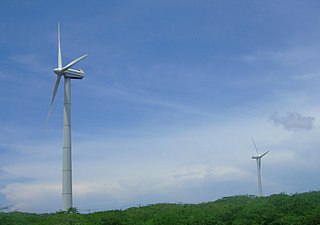
A combined cycle power plant is an assembly of heat engines that work in tandem from the same source of heat, converting it into mechanical energy. On land, when used to make electricity the most common type is called a combined cycle gas turbine (CCGT) plant, which is a kind of gas-fired power plant. The same principle is also used for marine propulsion, where it is called a combined gas and steam (COGAS) plant. Combining two or more thermodynamic cycles improves overall efficiency, which reduces fuel costs.
Puget Sound Energy, Inc. (PSE) is an energy utility company based in the U.S. state of Washington that provides electrical power and natural gas to the Puget Sound region. The utility serves electricity to more than 1.2 million customers in Island, King, Kitsap, Kittitas, Pierce, Skagit, Thurston, and Whatcom counties, and provides natural gas to 877,000 customers in King, Kittitas, Lewis, Pierce, Snohomish and Thurston counties. The company's electric and natural gas service area spans 6,000 square miles (16,000 km2).

The Huntly Power Station is the largest thermal power station in New Zealand and is located in the town of Huntly in the Waikato. It is operated by Genesis Energy Limited, a publicly listed company. The station has five operational generating units – three 250 MW coal-and-gas-fired steam turbine units, a 50 MW gas peaking plant, and a 403 MW combined cycle gas turbine plant. The station also plays an important role in voltage support for the Northland, Auckland and Waikato regions.

The Ceylon Electricity Board - CEB, was the largest electricity company in Sri Lanka. With a market share of nearly 100%, it controlled all major functions of electricity generation, transmission, distribution and retailing in Sri Lanka. It was one of the only two on-grid electricity companies in the country; the other being Lanka Electricity Company (LECO). The company earned approximately Rs 204.7 billion in 2014, with a total of nearly 5.42 million consumer accounts. It was a government-owned and controlled utility of Sri Lanka that took care of the general energy facilities of the island. The Ministry of Power and Energy was the responsible ministry above the CEB. Ceylon Electricity Board (CEB), established by the CEB Act No. 17 of 1969, was under the legal obligation to develop and maintain an efficient, coordinated and economical system of electricity supply in accordance with any licenses issued. The CEB was dissolved and replaced by 12 successor entities under the 2024 Electricity Act.

The Lakvijaya Power Station is the largest power station in Sri Lanka.

The Hambantota Wind Farm was a wind farm in Hambantota, Sri Lanka, owned and operated by the state-run Ceylon Electricity Board. The wind farm, which was located along south-eastern coast of Hambantota was the country's first state owned wind farm, and consisted of five NEG Micon M1500-600 wind turbines of 600 KW each. With a total installed capacity of 3 MW, the wind farm generated up to approximately 4,500 MWh of power a year.

The electricity sector in Sri Lanka has a national grid which is primarily powered by hydroelectric power and thermal power, with sources such as photovoltaics and wind power in early stages of deployment. Although potential sites are being identified, other power sources such as geothermal, nuclear, solar thermal and wave power are not used in the power generation process for the national grid.
Repowering is the process of replacing older power stations with newer ones that either have a greater nameplate capacity or more efficiency which results in a net increase of power generated. Repowering can happen in several different ways. It can be as small as switching out and replacing a boiler, to as large as replacing the entire system to create a more powerful system entirely. There are many upsides to repowering.

Ceylon Petroleum Corporation, commonly known as CEYPETCO (CPC), is a Sri Lankan oil and gas company. Established in 1962 and wholly owned by the Government of Sri Lanka, it is the largest oil company in Sri Lanka. It was formed in 1961 by nationalisation and expropriation of all private oil companies in Sri Lanka at the time of its formation. It is under the ownership of Ministry of Petroleum Resources Development headquartered in Colombo. It is the largest government owned company in the country, with an operational profit of Rs. 33.9 billion for the financial year 2020.

The Mampuri Wind Farms are a set of three wind farms located near the Lakvijaya Power Station, on the Kalpitiya peninsula, in Mampuri, Puttalam District, Sri Lanka. The wind farms, referred to as Mampuri-I, Mampuri-II, and Mampuri-III, was built successively, and consists of eighteen Suzlon wind turbines ranging from 1.25 MW to 2.10 MW. Mampuri-I was commissioned on 22 March 2010, and was the first wind farm in the country to reach the 10 MW installed capacity threshold. As the government only allows projects up to 10 MW, the three wind farms are registered under three different company names, namely Senok Wind Power, Senok Wind Energy, and Senok Wind Resource.

The Broadlands Dam is a 35 MW run-of-the-river hydroelectric complex currently under construction in Kitulgala, Sri Lanka. The project is expected to be completed in 2020, and will consist of two dams, and a power station downstream.

The Yugadanavi Power Station is a large oil-fired power station in Sri Lanka. The 300 MW power station is located in Kerawalapitiya, in the Western Province of Sri Lanka.
The Bowatenna Dam is a 100 ft (30 m) high gravity dam at Bowatenna, in Central Province of Sri Lanka. The dam was built in June 1981, and is used primarily for irrigation. A 40 MW power station is also constructed 5,800 ft (1,800 m) downstream, for hydroelectric power generation.
The Sapugaskanda is a 160 megawatt power station located in Sapugaskanda, adjacent to the Sapugaskanda Oil Refinery, in the Western Province of Sri Lanka. The power station consists of twelve generating units, supplied by MAN, and Siemens. Four of the units are rated at 20 MW, while the remaining eight are rated at 10 MW. The power station is operated by the Ceylon Electricity Board.
The Ace Embilipitiya Power Station is a 100 MW thermal power station in Embilipitiya, Sri Lanka. The heavy fuel oil-run power station was commissioned in March 2005, and was operated by Aitken Spence. The power station consisted of fourteen Caterpillar 16CM32C generation units of 7.11 MW each, which consumed approximately 550 tonnes of fuel oil per day. The Ministry of Power and Energy discontinued purchasing power from the private power station after its license expired in 2015, and hence was subsequently decommissioned.
The Kankesanthurai Power Station was a fuel oil-run thermal power station which was commissioned as part of the urgent plan by the Ceylon Electricity Board to overcome the 1990s power crisis. Construction of the power station began in August 1998, and the power station was commissioned three months later on 4 November 1998 in Kankesanthurai, in the Jaffna Peninsula of Sri Lanka. It was the biggest power station in the Jaffna region, at that time.
Chunnakam Power Station was a thermal power station in Chunnakam in northern Sri Lanka. Commissioned in 1958, the station is owned and operated by the state-owned Ceylon Electricity Board (CEB). It was decommissioned in 2013, and replaced by the Uthuru Janani Power Station, which is constructed less than 100m south of the Chunnakam Power Station.

The Sojitz Kelanitissa Power Station, is privately owned 172 MW diesel-fired combined cycle power station located in Kelanitissa, in the city of Colombo, Sri Lanka. It is owned by Sojitz Kelanitissa Private Limited, a subsidiary of Sojitz Corporation. The power station is located adjacent to the Kelanitissa Power Station, which is a separate government-owned power station.

Vallibel Power Erathna PLC is a renewable energy company in Sri Lanka. The company operates three small hydropower projects. The company was incorporated in 2001 and in 2006, the company was listed on the Colombo Stock Exchange. Vallibel Power Erathna won the special honoree award in Forbes Asia's Best Under a Billion awards in 2015. Two projects of the company were eligible for the United Nations' Clean Development Mechanism.












